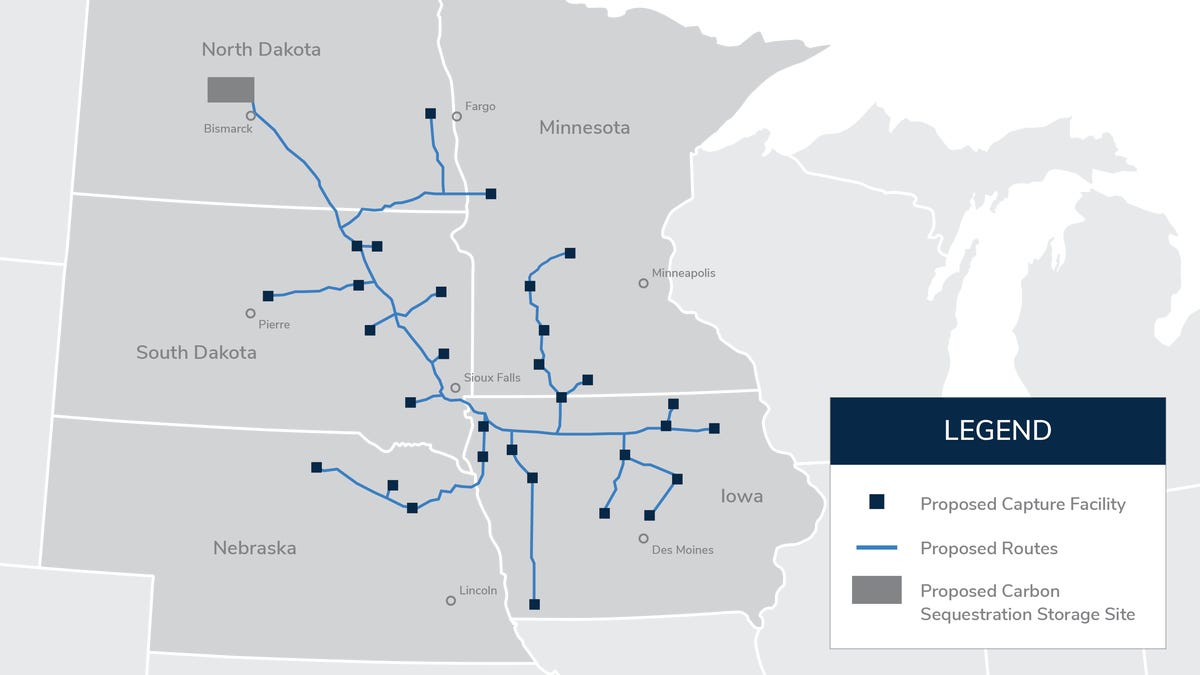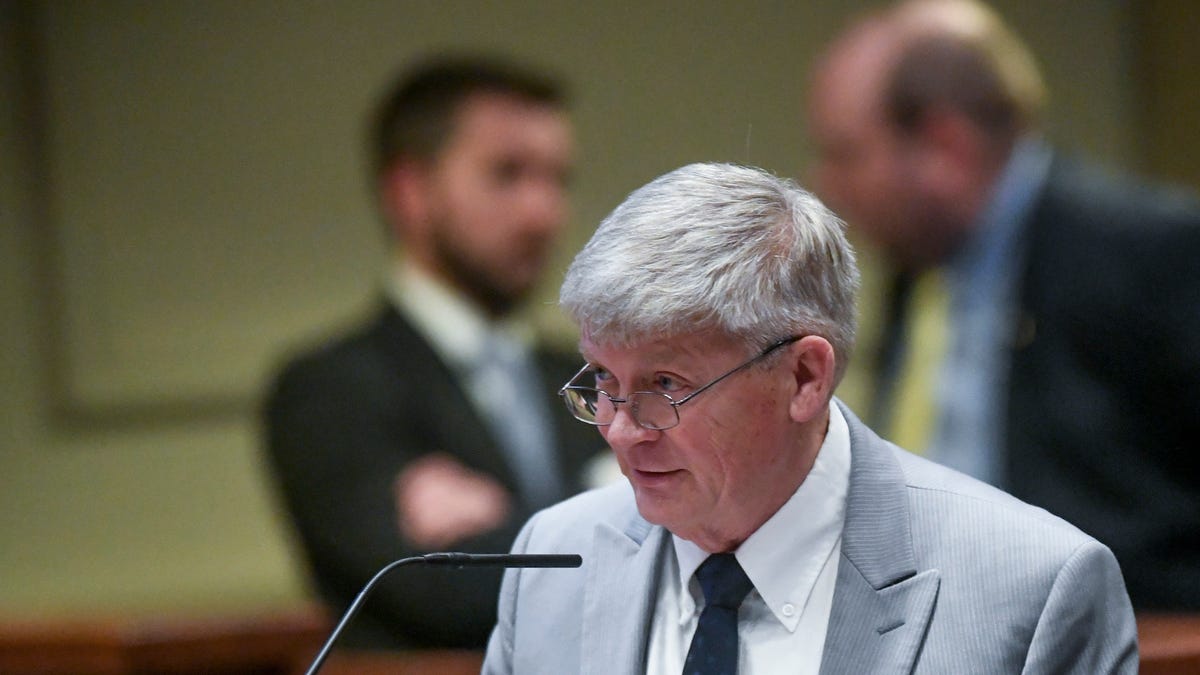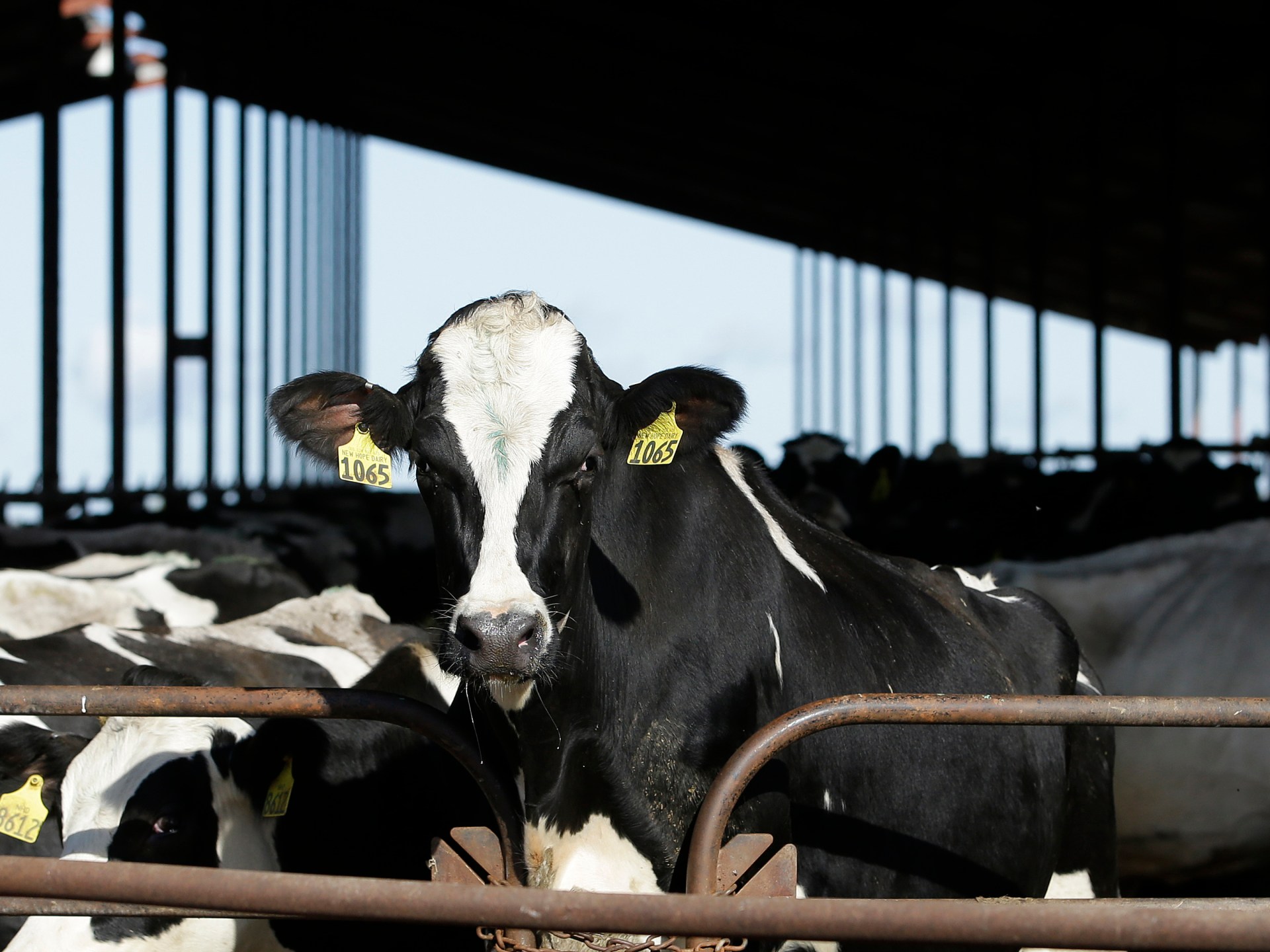South Dakota
Eminent domain is the latest front in South Dakota’s carbon pipeline fight

Some of the most contentious, emotionally charged debates during the 2024 South Dakota legislative session have been about property rights and whether a private company can use eminent domain to force a carbon dioxide pipeline onto land against the owner’s will.
The heated discussions are driven by a proposal from Summit Carbon Solutions to run 470 miles of a 1,900-mile underground pipeline across eastern South Dakota. The pipe would carry liquified carbon dioxide gas from regional ethanol plants to North Dakota, where it would be stored deep underground and kept out of the atmosphere.
In all, lawmakers are weighing 10 bills related to the pipeline and eminent domain, which requires landowners to be paid for the use of their land but gives them little legal recourse to stop it.
“The core of the issue is about taking people’s lands, and it’s starting to infringe on the American way,” Joy Hohn, whose family farm west of Sioux Falls near Hartford is on the proposed pipeline route, told News Watch.
“Prior to this, our eminent domain laws were for projects that were for the good of the people and that benefit the public. But when you have an out-of-state, foreign-backed company using the threat of eminent domain in their dealings, it’s not good and people are really fired up about that.”
Kirk Yackley, who farms northeast of Pierre near Onida, said he has heard of landowners being bullied, but said he had a good experience with Summit representatives.
Yackley is one of the roughly 3 out of 4 South Dakota landowners along the route who have signed voluntary easements allowing the CO2 pipeline on their land, according to Summit. In his case, the line would cut across about a half-mile of his family’s 9,000-acre farm.
“They were very professional and respectful,” he said of Summit representatives.
The state Public Utilities Commission in September rejected Summit’s application after regulators said there were too many conflicts between the proposed route and county guidelines for setbacks between utility projects and existing structures.
Summit officials have said they will refile their permit request once they iron out differences and obtain the voluntary easements needed to site the project. They’re also supporting a change in state law to eliminate the ability of counties to regulate pipeline locations.
“We continue to work with landowners and community leaders across the state to find a mutually agreeable path,” Sabrina Zenor, a spokeswoman for Summit, wrote in an email to News Watch. “We heard the South Dakota PUC’s request to work with counties.”
Summit hopes to receive voluntary easements from 100% of property owners along the route, she said. The company has secured them from 75% of South Dakotans, and the documents would apply when the company resubmits an application to the state PUC, Zenor wrote.
Voluntary easement rates in other states include 72% in Nebraska, 75% in Iowa, and 90% in North Dakota and Minnesota, she wrote.
Another company, Navigator CO2 Ventures, dropped its proposal for a pipeline in the region, leaving Summit as the only active project. The companies hope to qualify for billions of dollars in federal tax credits aimed at reducing greenhouse gasses.
Some scientists question the efficacy and value of carbon capture and sequestration pipelines, arguing the federal subsidies could be used in more proven, efficient ways to reduce climate change.
But supporters said the pipelines will help the atmosphere and provide foundational support to the U.S. ethanol industry and the corn growers who back it.
South Dakota produces $2.9 billion worth of ethanol annually. Summit’s plan would collect CO2 from nearly three dozen ethanol plants, including a handful in the state.
Backers also have said the pipeline is a key component of the proposed $1 billion Gevo plant in northeast South Dakota at Lake Preston that would use corn to make biofuels for the airline industry.
At one point during this legislative session, the debate over property rights became so emotional that Rep. Steven Duffy, a Rapid City Republican, said he and another lawmaker had to leave the committee hearing together in order to maintain their safety.
Duffy said the temperature of the debate has fallen since then, but concerns among affected landowners remain high.
One of the leading eminent domain opponents, Rep. Jon Hansen, a Dell Rapids Republican, sponsored House Bill 1219, which would prohibit the use of eminent domain specifically for pipelines that would carry carbon dioxide.
“It’s about protection of our people, the people of South Dakota,” he said. “It’s about saving South Dakotans from being the subject of hundreds of lawsuits, condemnation lawsuits, simply for owning land and saying no thank you to a purchase offer.”
Eminent domain was intended to allow legal taking of private land while also providing appropriate compensation for government projects that serve a public good and not for private companies that seek to turn a profit, Hansen said.
“This bill is about protecting South Dakota landowners’ constitutional private property rights from, frankly, the bullying and harassment we have seen inflicted on our people in this state by an out-of-state, for-profit, foreign-backed company over the last year,” he said.
A committee rejected the bill by a 7-6 vote, but it was ultimately moved forward without a formal recommendation. It could still be heard on the floor of the House of Representatives through a procedure known as a “smoke out.”
Duffy, a member of the House Commerce & Energy Committee, said he opposed the bill to prohibit use of eminent domain for carbon dioxide pipelines because pipeline companies already have invested upwards of $70 million to get their project sited and approved in South Dakota and four other states.
“Whether you should have eminent domain for private industry, that’s a different issue. But I don’t think it’s fair to say we should change the rules now,” Duffy said Feb. 17 at a legislative cracker barrel in Rapid City.
Reform of eminent domain laws might be needed, but it sends a negative message to business and industry if the state changes the laws once a development process has begun, he said.
“It probably does need to be looked at down the road. But I think it’s not fair to change it right now in the middle of the game,” Duffy said. “That sends a signal to other people that South Dakota may not be business friendly. If they followed the rules, and I assume they did … it’s hard for me to say, ‘OK, now you can’t (use eminent domain.)’”
Another highly contentious eminent domain bill, Senate Bill 201, would provide a statewide framework for approval of pipeline projects.
The measure was co-sponsored by Senate Majority Leader Casey Crabtree of Madison and House Majority Leader Will Mortensen of Pierre. The two Republicans have said the measure would streamline the pipeline siting process while also providing protections for landowners and financial help for counties where pipelines are laid.
The bill would bar counties from passing structure setback rules that make pipelines virtually impossible within their boundaries but also provide surcharge payments to counties and require companies to pay for damages to landowners.
In a recent newsletter to constituents, Crabtree called the bill a “comprehensive solution that protects landowner rights and establishes clear infrastructure guardrails.”
“South Dakota is open for business, which means we don’t set up roadblocks for projects through regulation, red tape, excessive fees, and indefinite timelines. We provide fairness and certainty in the process for landowners and businesses,” Crabtree wrote.
And yet, the measure faces opposition from many landowners who said it would eliminate local control and the ability of individual counties to regulate and possibly ban pipelines within their borders.
A few counties, including Brown, Lincoln and McPherson, have passed or considered measures that would ban pipelines or enforce setback rules that could make the pipelines unfeasible within their borders.
“It’s stripping away local control,” Hohn said. “It would take away county ordinances that were put in place by a handful of counties that took great care to make sure the intelligent land use and economic development was looked at for their long range plans.”
Craig Schaunaman, a former lawmaker whose Brown County farm is on the Summit pipeline route, said he faced eminent domain and condemnation proceedings after Summit sought to build the CO2 pipeline across 2.5 miles of his grain farm south of Aberdeen.
Summit representatives did not share his “South Dakota values” and did not deal with him in good faith, he said. Schaunaman said as many as 200 South Dakota landowners are facing or have faced eminent domain proceedings due to their opposition to the pipeline project.
“South Dakota has always had an open door for business, but what we haven’t always been is for sale,” he said. “It’s our land. And I think if it goes beyond the government taking it, I should be able to say yes or no. Now we seem to have changed that direction and anybody who wants an economic benefit can come in, condemn the land and take it. And philosophically I can’t agree with that.”
Some landowners opposed to the pipeline said it can make their land difficult to farm and also brings health risks associated with possible leaks of the toxic, liquified CO2.
A number of them have organized.
They regularly drive to hearings in Pierre and have formed a group called Landowners for Eminent Domain Reform. They also created a website to share stories of how they have willingly allowed government use of their land for public projects but believe using eminent domain for business is against South Dakota values. Some have shared that they are enduring sleepless nights as they said they battle to protect their land and livelihoods.
“If you want to stand up for what is rightfully yours, it’s very time consuming and a financial burden,” Hohn told News Watch.
According to the Institute for Justice, a nonprofit legal group that monitors eminent domain cases nationwide, the Fifth Amendment to the U.S. Constitution allows for eminent domain only for “public use” and with compensation provided to the property owner. But the institute notes that a 2005 U.S. Supreme Court case, Kelo V. New London, expands eminent domain to allow government and even private entities to use eminent domain for projects that will produce more taxes or new jobs.
The institute gives South Dakota an A grade due to a 2006 state Supreme Court ruling regarding the right of a landowner to prevent hunters from accessing their land that the institute believes weakened the applicability of the Kelo ruling in South Dakota.
The president of one of South Dakota‘s largest agricultural groups, Doug Sombke of the South Dakota Farmers Union, said the public at large should be concerned that under current eminent domain laws, their personal property including land, homes and even cars could be taken without consent by private companies seeking a profit.
“This is not just a farmland issue, this is real for every South Dakotan who owns anything because this can happen to your home, business or any property you own,” he said. “Somebody can come in for private gain, a for-profit business, and they could literally come in and wipe our your whole neighborhood and the only alternative you have is to determine what that property was worth.”
Yackley, the Sully County farmer who signed a voluntary easement with Summit, said company representatives who visited with him answered his questions and made some concessions during the easement negotiation process.
He said he isn’t sure of the value and efficacy of the carbon capture process, but he believes the pipeline will help protect the state ethanol industry while boosting the overall state agricultural economy.
Yackley said he received a settlement that would pay him significantly higher than market value for the land where the pipeline would be built.
He testified in 2023 before the Legislature in favor of the Summit project, but he doesn’t begrudge any landowner of their right to deny Summit access to their land or their ability to say no to the company.
“I have two neighbors who are dead set against the pipeline,” Yackley said. “And I told them to go ahead, that it’s their right to fight it.”
Yackley also said he has heard from people he knows well that Summit representatives did pressure them to allow the pipeline on their land.
“I’ve got friends up north that I trust, and they tell me they were bullied (by Summit). And I believe them because they had no reason to lie to me,” he said. “We just didn’t have that, and I’m sorry that they did.”
— This article was produced by South Dakota News Watch, a non-profit journalism organization located online at sdnewswatch.org.

South Dakota
South Dakota’s recreational marijuana campaign readies another ballot run

Matthew Schweich hopes that when it comes to recreational marijuana legalization in South Dakota, the third time is the charm.
“Everything’s on schedule,” said the campaign director of South Dakotans for Better Marijuana Laws, whose group handed in 29,030 signatures for its recreational pot initiated measure to the Secretary of State’s office in Pierre on Tuesday, the final day that signatures could be submitted for 2024.
It’s been a mad dash to the finish line for the pro-legalization group, which also had a hand in putting the issue on the ballot in 2020 and 2022. The effort got a late start due to concerns about funding and didn’t really hit its stride with paid circulators until February.
“I think it would have been a mistake to launch a signature drive without knowing we had the resources to do it properly,” said Schweich, adding that funding for the petition drive came from the Grow South Dakota Ballot Committee (with former state legislator Deb Peters as treasurer) and Puffy’s Dispensary, a West River-based medical cannabis operation.
The number of verified signatures needed to qualify initiated measures for the ballot is 17,508, which represents 5% of the total vote for governor in the last gubernatorial election. Constitutional amendments require 35,017, which is 10%.
After receiving a petition, state law requires the Secretary of State to “examine and catalog” the signatures and make them available to the public upon request for a reasonable fee. Within five days of that examination, the Secretary of State is required to generate a random sample to determine the validity of the signatures, with the validation sheets also available for public inspection.
If the recreational marijuana measure makes the ballot, the campaign will have to grapple with possible voter fatigue on an issue that will be put before South Dakota voters for a third consecutive statewide election.
In 2020, pro-legalization Amendment A passed with 54% of the vote, clearing the way for recreational marijuana to be implemented in the state. Medicinal pot was also approved by voters that year in an initiated measure.
Gov. Kristi Noem’s administration challenged the recreational marijuana amendment, saying it violated the state’s requirement that constitutional amendments deal with just one subject. That argument prevailed in a 4-1 decision at the South Dakota Supreme Court.
Supporters tried to pass recreational cannabis again in 2022, and South Dakotans rejected that effort, sending Initiated Measure 27 to defeat with 53% of voters against it.
Schweich acknowledges making a political miscalculation by going back to the issue in 2022 rather than “taking a breather” and waiting for 2024, a presidential election year with higher voter turnout than midterms.
“My theory was that the anger over the amendment being overturned would cause a whole bunch of voters who might not otherwise show up for the midterms to go out and vote,” said Schweich, who also runs Eagle Campaigns, a political campaign service in Sioux Falls. “It was an ambitious theory, and unfortunately things didn’t play out that way. It turns out that changing an electorate is very difficult.”
South Dakotans for Better Marijuana Laws will focus on get-out-the-vote efforts rather than trying to win “the hearts and minds” of voters on an issue that they are well-versed on following the 2020 and 2022 campaigns.
Recreational marijuana is currently legal in 24 states, with supporters pointing to economic advantages to the state economy from tax revenue. States collected nearly $3 billion in marijuana revenues in 2022, according to the Tax Foundation.
Opponents cite potential social costs and health risks such as a higher risk of cardiovascular problems from marijuana use, as outlined in a recent study in the Journal of the American Heart Association.
If the measure makes the ballot and fails, said Schweich, there will not be a fourth consecutive time on the ballot, at least from his group.
“If we fail in 2024, which I don’t think will happen, I will respect that and will not be part of putting this issue on the ballot in 2026,” said Schweich.
This story was produced by South Dakota News Watch, an independent, nonprofit news organization. Read more in-depth stories at sdnewswatch.org and sign up for an email every few days to get stories as soon as they’re published. Contact Stu Whitney at at stu.whitney@sdnewswatch.org.
South Dakota
New genus of tiny, hornless deer that roamed South Dakota 32 million years ago discovered

A new genus of tiny, hornless deer that lived in South Dakota during the Oligocene Epoch approximately 32 million years ago has been discovered by a team of researchers from Badlands National Park, the American Museum of Natural History and California State Polytechnic University, officials said.
The new deer, called Santuccimeryx, meaning “Santucci’s ruminant”, was named after Vincent L. Santucci, the Senior Paleontologist and Paleontology Program Coordinator in the Geologic Resources Division of the National Park Service “to honor his history with and advocacy for the paleontology program at Badlands National Park,” according to a statement from the National Park Service announcing the discovery.
A high definition photo of the Santuccimeryx skull discovered at Badlands National Park in 2016.
National Park Service
The research was published this week in the “Proceedings of the South Dakota Academy of Science.”
“Santuccimeryx belongs to the extinct family Leptomerycidae, and its skull shares features of both the Oligocene genus Leptomeryx and the Miocene genus Pseudoparablastomeryx, two animals that are nearly 10 million years apart in time,” NPS said in their statement. “The family Leptomerycidae were about the size of house cats and lived in North America from the late-middle Eocene (about 41 million years ago) to the end of the middle Miocene (about 11 million years ago). They are considered close relatives to the living chevrotains, or mouse deer, from the tropical forests of central and western Africa and southeast Asia.”
The new genus of deer has teeth very similar to Leptomeryx and a skull resembling that of the Pseudoparablastomeryx, officials said.
“Since it does not fit into either existing genus, [officials] concluded the deer must be placed into a new genus of its own,” NPS said.

A paleoartistic reconstruction of the newly named genus Santuccimeryx elissae, shown standing in front of hackberry bushes. Its small size (3-5 lbs), relatively large orbits, and shortened skull differentiate Santuccimeryx from the tiny Oligocene deer Leptomeryx. Illustration by Benji Paysnoe.
Illustration by Benji Paysnoe.
“I am both personally and professionally grateful to be associated with this important new fossil discovery from Badlands National Park, where I began my career as a paleontologist with the National Park Service in 1985,” Santucci said.
The research was prompted when the first — and still only known skull of the deer — was discovered at Badlands in 2016.
“It’s a really neat example with this paper to be able to highlight citizen science, because this is the only skull of this animal ever found,” Mattison Shreero, who headed up the research, said. “And if somebody had walked away with it, or if they just hadn’t reported it and it had eroded away, we would have never known about it.”
Visitors at Badlands who spot what they think might be a fossil or artifact are asked to leave it in place and submit a Visitor Site Report at the Visitor Center, with a park ranger, or by email information about their find to Badlands_fossil_finds@nps.gov.
South Dakota
South Dakota joins pushback against new EPA coal rules • South Dakota Searchlight

South Dakota has joined a group of states, led by North Dakota and West Virginia, in asking a federal court to review new pollution standards impacting the coal industry.
Attorneys general from 23 states signed the petition asking for a review of the regulations that took effect Tuesday. The final proposed rules became public on April 25.
“This rule intentionally sets impossible standards to destroy the coal industry,” North Dakota Attorney General Drew Wrigley said in a news release.
Wrigley said the Biden administration has ignored limits on its authority set by Congress.
“Federal agencies cannot decide on a whim to destroy entire industries,” Wrigley said.
North Dakota prepares to fight EPA rule one official calls a ‘death penalty for coal’
The petition was filed Wednesday in the U.S. District Court of Appeals in Washington, D.C., asking the court to review the Environmental Protection Agency rule.
Other states that signed the petition were Alaska, Arkansas, Georgia, Idaho, Indiana, Iowa, Kansas, Kentucky, Louisiana, Mississippi, Missouri, Montana, Nebraska, Oklahoma, South Carolina, South Dakota, Tennessee, Texas, Utah, Virginia and Wyoming.
In its announcement of the rules on April 25, EPA Administrator Michael Regan said “EPA is cutting pollution while ensuring that power companies can make smart investments and continue to deliver reliable electricity for all Americans.”
In particular, North Dakota officials have taken issue with new, stricter mercury emissions standards.
Dave Glatt, director of the North Dakota Department of Environmental Quality, said the mercury standard provides no measurable health benefits and are a “death sentence for coal.”
Jason Bohrer, president and CEO of the Lignite Energy Council, released a statement after the final rule was announced in April.
“Electricity demand is surging, and the EPA’s agenda will severely impact our ability to rely on electricity 24/7,” Bohrer said. “These regulations mandate either fuel switching or the implementation of unproven technology, jeopardizing the stability of the national power supply, and putting over 12,000 jobs in the lignite industry at risk.”
The Lignite Energy Council says the North Dakota coal industry contributes $5.75 billion to the state economy and more than $100 million in state and local taxes.
In addition to mercury reductions, the new rules also lower the levels of pollutants that coal-fired power plants can discharge through wastewater, sets standards for handling coal ash and sets limits on carbon emissions. North Dakota Gov. Doug Burgum and other state officials have repeatedly complained about onerous regulations from the Biden administration, with Burgum even making a plea to a legislative committee to provide adequate funding for the state’s legal battles with the federal government.
GET THE MORNING HEADLINES DELIVERED TO YOUR INBOX
-

 Politics1 week ago
Politics1 week agoThe White House has a new curator. Donna Hayashi Smith is the first Asian American to hold the post
-

 World1 week ago
World1 week agoTurkish police arrest hundreds at Istanbul May Day protests
-

 Politics1 week ago
Politics1 week agoAdams, NYPD cite 'global' effort to 'radicalize young people' after 300 arrested at Columbia, CUNY
-

 News1 week ago
News1 week agoPolice enter UCLA anti-war encampment; Arizona repeals Civil War-era abortion ban
-

 News1 week ago
News1 week agoSome Republicans expected to join Arizona Democrats to pass repeal of 1864 abortion ban
-

 News1 week ago
News1 week agoVideo: Police Arrest Columbia Protesters Occupying Hamilton Hall
-
)
) Movie Reviews1 week ago
Movie Reviews1 week agoThe Idea of You Movie Review: Anne Hathaway’s honest performance makes the film stand out in a not so formulaic rom-com
-

 Politics1 week ago
Politics1 week agoNewsom, state officials silent on anti-Israel protests at UCLA
















